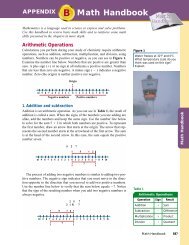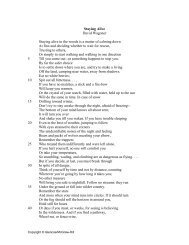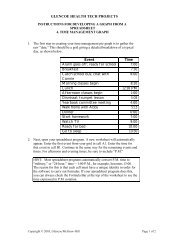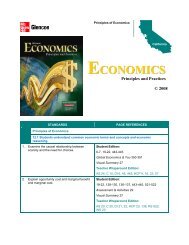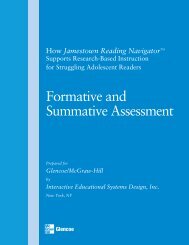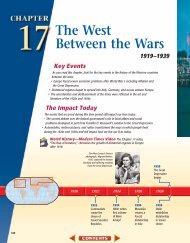Comprehension - Research
Comprehension - Research
Comprehension - Research
Create successful ePaper yourself
Turn your PDF publications into a flip-book with our unique Google optimized e-Paper software.
instructional<br />
recommendations<br />
• Graphic organizers. As defined by the NRP, graphic organizers refers specifically to a method in which<br />
“teachers instruct students to organize their ideas through the construction of graphs of ideas based upon<br />
what they read” (NICHHD, 2000, p. 4-73). The NRP identified this as a strategy with a firm scientific<br />
basis, based on 11 studies (grades 2–8) involving use of content-area texts (social studies and science)<br />
(NICHHD, 2000, p. 4-45). 15<br />
− According to Kamil (2003), “Graphic organizers are alternative representations of text, visual or<br />
spatial. Graphic organizers include semantic networks, concept maps, or text maps. . . . Graphic<br />
organizers can be used before, during, or after reading” (Kamil, 2003, p. 13; emphasis in original).<br />
• Mental/visual imagery. Training students to create visual imagery was specifically endorsed by Nokes<br />
and Dole (2004) as a strategy that has “yielded positive results” (p. 173).<br />
− While the NRP did not conclude that teaching students to use mental/visual imagery had a “firm<br />
scientific basis,” the report did state, “Mental imagery . . . strategies have reliable effects on<br />
improving memory for text. . . . These procedures are useful for recall of individual sentences or<br />
paragraphs” (NICHHD, 2000, p. 4-42, citing five studies in grades 2–8). 16<br />
− Similarly, Pressley (2000) included “construction of mental images representing the meanings<br />
expressed in text” as being among the “[s]trategies that proved their worth” in research on<br />
teaching of individual comprehension strategies (p. 554, citing Gambrell & Bales, 1986; Gambrell<br />
& Jawitz, 1993; Pressley, 1976).<br />
• Activation of prior knowledge. According to Pressley (2000), “The mature reader knows much about the<br />
world. Such prior knowledge affects comprehension” (p. 549).<br />
− Pressley went on to endorse prior knowledge activation as a strategy that was supported by<br />
existing research (p. 554, citing Levin & Pressley, 1981).<br />
− Based on a review of 14 studies (grades 1–9), the NRP stated, “The activation of relevant world<br />
knowledge helps children understand and remember what they read. The activation of prior<br />
knowledge occurs naturally in contexts in which subject content is taught by the teacher, and<br />
readers then read text that relates to what has been learned. Prior knowledge activation occurs<br />
with several strategies, notably question elaboration, generation, and answering” (NICHHD,<br />
2000, p. 4-85). 17 However, the strategy did not reach the threshold of firm scientific basis in the<br />
NRP’s view.<br />
• Critical reading. A variety of sources attest the importance of teaching students to read critically as an<br />
important outcome of comprehension instruction. This argues for the potential usefulness of instruction<br />
that focuses explicitly on the development of such critical reading skills.<br />
J a m e s t o w n R e a d i n g N a v i g a t o r<br />
− In their discussion of content-area literacy, Readence et al. (2004) noted, “Critical thinking has<br />
been a part of curriculum design in the United States for many years, generally in the form of<br />
helping students distinguish facts from opinions, instances of propaganda, and so on” (p. 32).<br />
− Underwood and Pearson (2004), in their critique of the “intense instructional emphasis on print<br />
skills” in the 1990s (pp. 138–139), argued instead for “a balance that does justice to issues of<br />
comprehension, writing in response to reading, and critical examinations of text” (p. 139).<br />
15 Alvermann & Boothby, 1983, 1986; Armbruster, Anderson, & Meyer, 1991, 1992; Baumann, 1984; Berkowitz, 1986; Darch, Carnine,<br />
& Kame’enui, 1986; Gordon & Rennie, 1987; Simmons et al., 1988; Sinatra, Stahl-Gemake, & Berg, 1984; Vidal-Abarca &<br />
Gilabert, 1995.<br />
16 Borduin et al., 1994; Gambrell & Bales, 1986; Peters & Levin, 1986; Pressley, 1976; Shriberg et al., 1982. We note that the text<br />
description in the National Reading Panel chapter on <strong>Comprehension</strong> stated that seven studies were reviewed for mental imagery<br />
(NICHHD, 2000, pp. 4-43, 4-75); however, only five studies were listed in the Mental Imagery References section.<br />
17 Au, 1980; Brown et al., 1977; Dewitz et al., 1986; Dole et al., 1991; Hansen & Pearson, 1983; Manzo, 1979; Linden & Wittrock,<br />
1981; Neuman, 1988; Palincsar & Brown, 1984; Prince & Mancus, 1987; Roberts, 1988; Spires et al., 1992; Tharp, 1982; Wood et<br />
al., 1988.<br />
12




